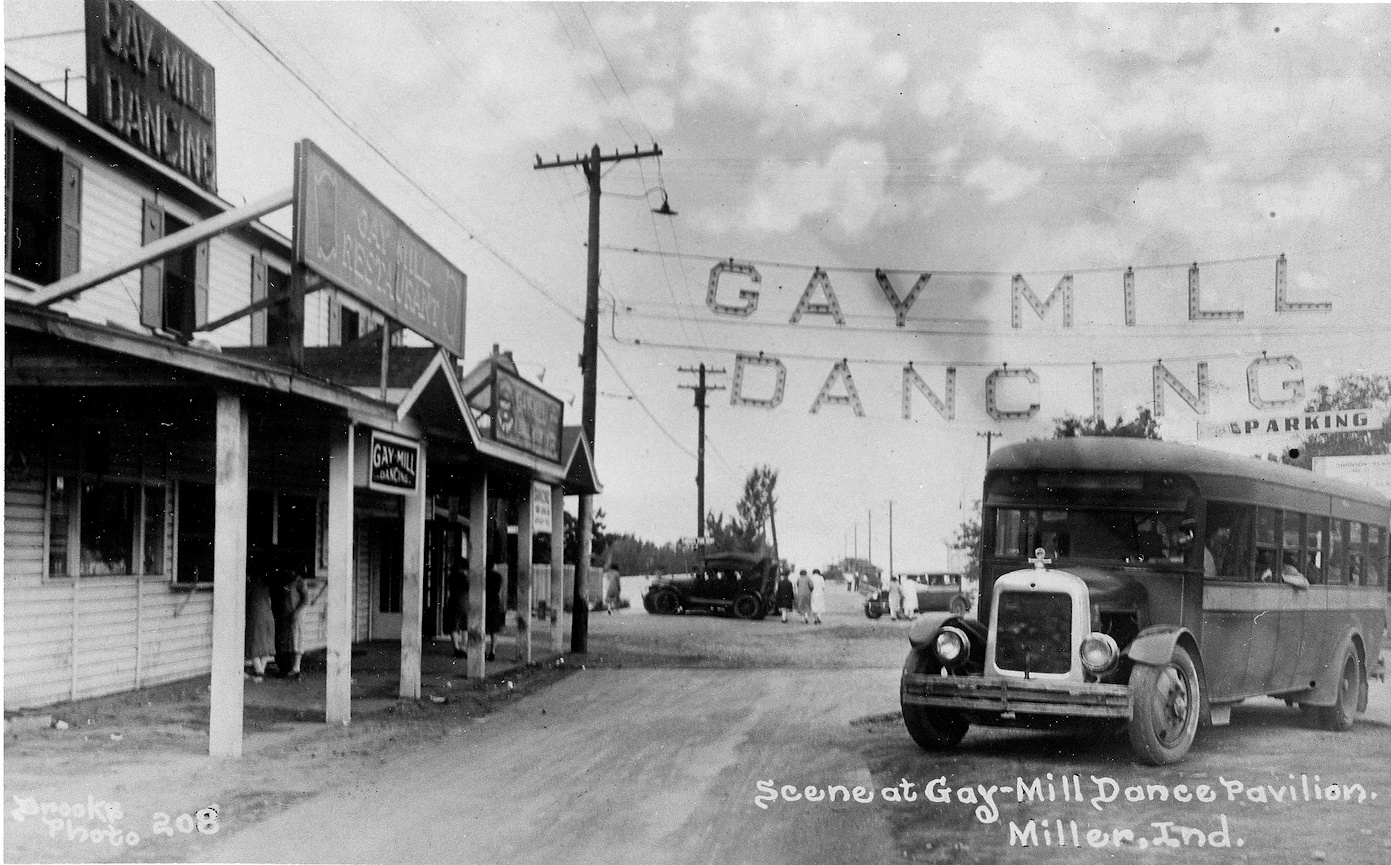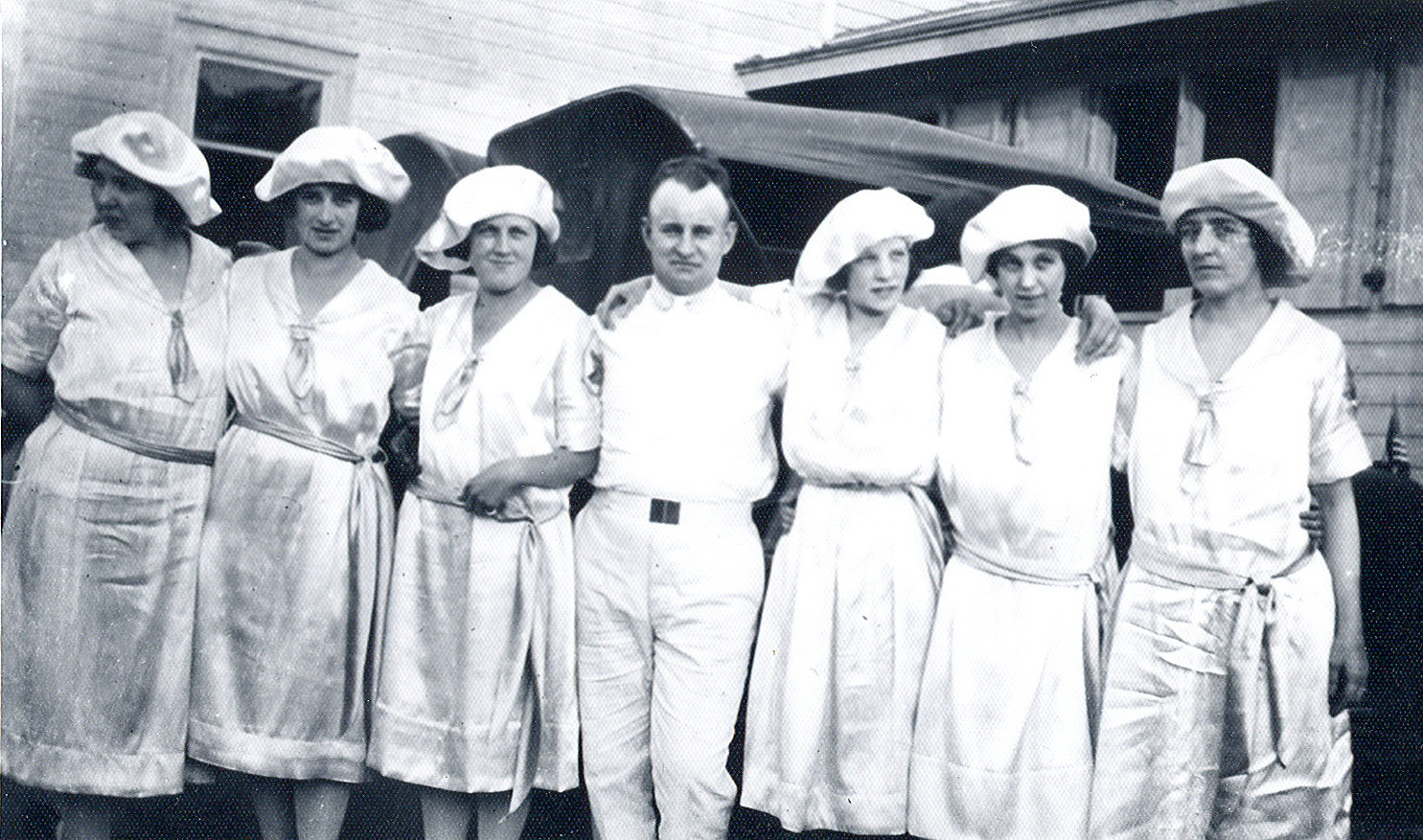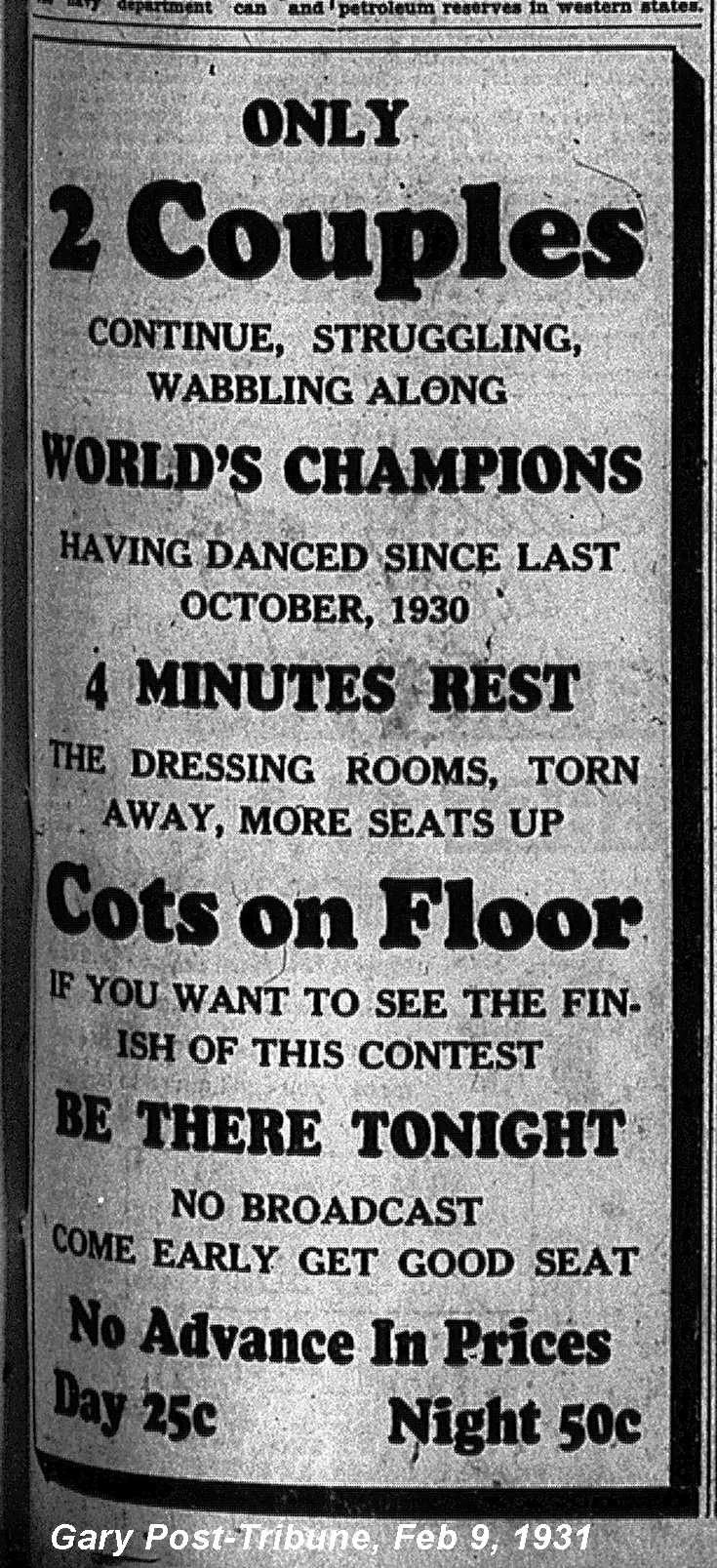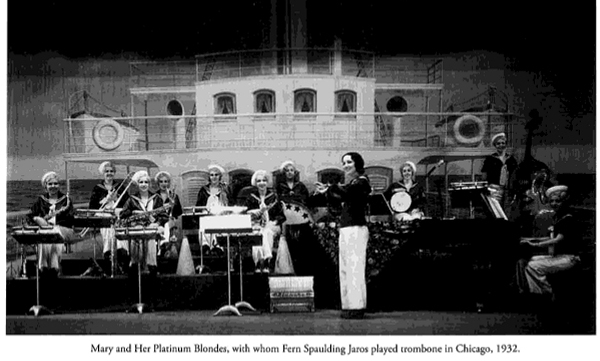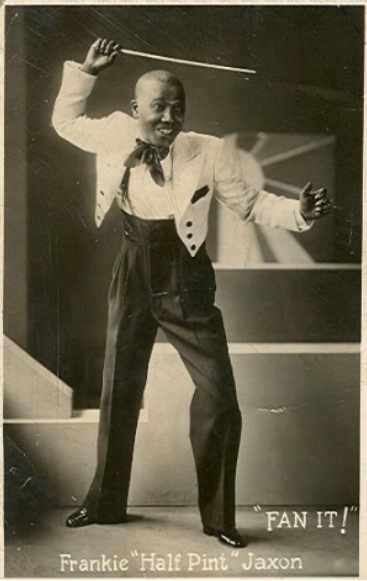The Roaring Twenties
Come to Miller Beach
In Two Parts
This being the story of Gay Mill Gardens
Part Two being "The Voice of the Steel City"
The Story of Miss Frances Kennedy
"The Merriest Comedienne"
Gay Mill was also the home of the region's first radio station.
.jpg) Click to read about that on a separate page.
Click to read about that on a separate page.
Dancing. Dance orchestras. The "Miss Indiana" pageant. The region's first radio station.
These were brought to the people of Miller Beach in the 1920s at Gay Mill Gardens by Chicago Attorney Thomas J. Johnson and his wife, “The Merriest Comedienne,” Frances Kennedy.
For a decade it was the place to be by day or night all year long.
In the summer of 1918 Chicagoans Thomas Johnson and his wife Frances Kennedy put their 13 and 8 year old children, Thomas, Jr. and Frances, in the car and headed to New York for a vacation. They never got past Miller beach. According to Archibald McKinlay, writing in 1989 likely with the benefit of the memories of the Johnson children, three days on Miller beach cleared up the cough of young Thomas which they had feared was tuberculosis. They decided to build a cabin, but the only way to acquire the land was to buy 80 acres in possession of a Boston owner, which they did.(Footnote: McKinlay, Archibald, “Calumet Region winds down to radio station.” Hammond Times, April 9, 1989, page 76 Main Edition. )
In late July of 1920, while Frances was performing at the Palace theater in Chicago, the cabin burned, seriously injuring the younger Frances and her father. (Footnote: “Lawyer Burned Saving Child in Blazing Home,” Chicago Tribune, July 25, 1920. ) Frances was busy that summer with performances in Chicago but was already the darling of Miller folk. They saw to quick rebuilding of her summer cottage and on September 5th she staged a Water Carnival in Miller “in gratitude to her friends and neighbors of Miller and Gary who assisted her to rebuild her summer home.” Prizes in aggregate of a thousand dollars were promised. (Footnote: “Frances Kennedy to Give Water Carnival at Miller” Chicago Tribune, August 14, 1920, page 6. )
Where was it? - the most asked question:
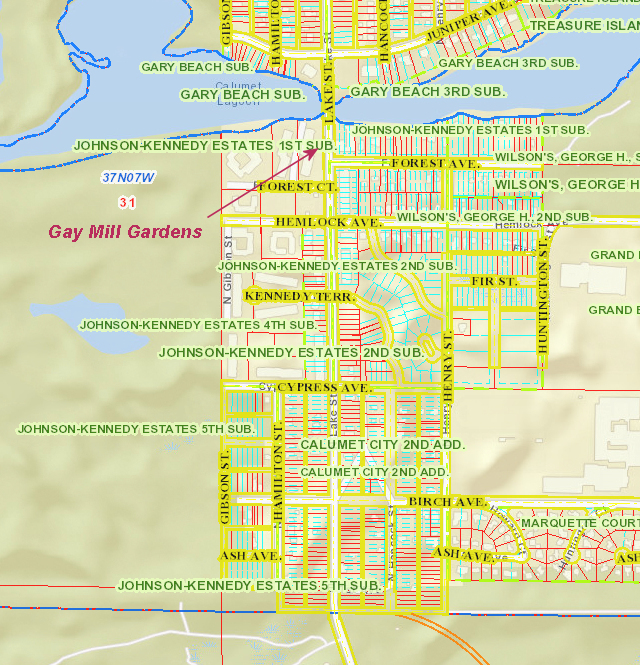
 Click the map to enlarge.
Click the map to enlarge.
Not sure where this is? Go to Google Maps
Putting aside the idea of building a tuberculosis sanitarium, they conceived of a plan to erect “…a place where the younger element could enjoy themselves in clean, wholesome dancing.” (Footnote: “Big Doings at Gay Mill,” Hammond Times, July 25, 1925, page 5. The timeline is a bit confusing in this article. The 1925 article says that it was 7 years ago (1918) that they discovered Miller beach. And 1925 marked the “Fifth Anniversary of the Foundation of Gay Mill.” So extrapolating they built the first concrete floor outside in 1920 and in 1921 they built Gay Mill. Arch McKinlay says that in all they made seven additions to the original structure. In any case “Gay Mill” did not begin to show up in newspaper ads until 1922. ) They filed a legal action in 1921 to quiet claim to a good deal of land either side of Lake street south of the Grand Calumet lagoon, land which would become known as the Johnson-Kennedy Estates; there were literally hundreds of named defendants in the case that Frances brought to clear title to the land: from the Ewings, original patentees, to Potawatomie Indians. (Footnote: One reporter said there were 317 named in the suit. I didn’t count them. ) With the land theirs, they built an outdoor dance floor, parking lot and concession stands, and drove off competitors who had set up rival concessions on their land. (Footnote: “Court Grants The Johnson Injunction,” Hammond Times, May 21, 1921. Page 9. )
Plans went ahead in the winter and into the spring of 1922, building a substantial facility which they named Gay Mill, derived from the names of the two towns,
Gary-Miller. Gay Mill got off to a rocky start on April 27, 1922 with a boxing show with a “…thirty round all-star boxing card,” organized by boxing promoter
Jack O’Shay. It was to be held in the Gay Mill pavilion which was claimed to have a seating capacity of 1200.
(Footnote:
“Will Stage Boxing Show,” Hammond Times, April 20, 1922, page 9.
)
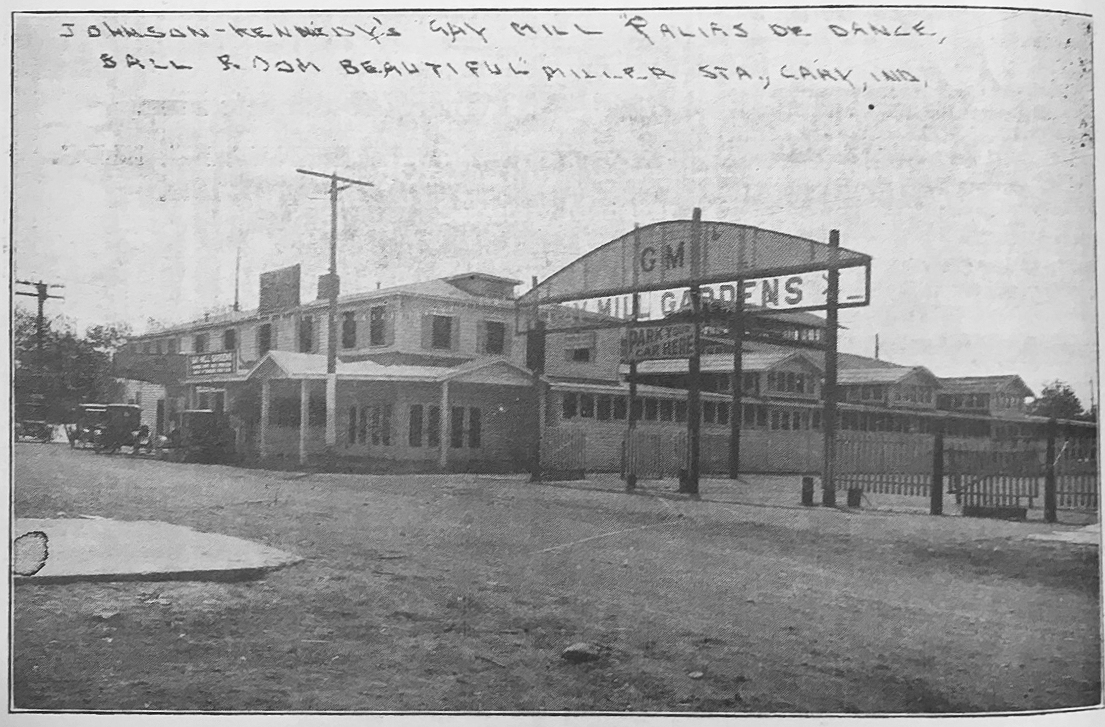 Only about 200 fight fans showed up, the fighters
refused to fight, and Johnson refunded the ticket cost to the fans.
(Footnote:
“Gary Bouts A Farce,” Hammond Times, April 28, 1922, page 5.
)
While little advertising was purchased in the newspapers in 1922, dancing at Gay Mill
began May 26th and started drawing folks from Gary and Lake county, the paper declaring that it “…promises to be one of the most popular places at the beach
this summer.”
(Footnote:
Hammond Times, June 9, 1922, page 1.
)
Another popular spot, the municipal bath house, opened that summer not far east of Lake street and Gay Mill.
Only about 200 fight fans showed up, the fighters
refused to fight, and Johnson refunded the ticket cost to the fans.
(Footnote:
“Gary Bouts A Farce,” Hammond Times, April 28, 1922, page 5.
)
While little advertising was purchased in the newspapers in 1922, dancing at Gay Mill
began May 26th and started drawing folks from Gary and Lake county, the paper declaring that it “…promises to be one of the most popular places at the beach
this summer.”
(Footnote:
Hammond Times, June 9, 1922, page 1.
)
Another popular spot, the municipal bath house, opened that summer not far east of Lake street and Gay Mill.
1923 saw Gay Mill Gardens, as it was now called, begin to attract more dancers, and orchestras. Frances, while touring heavily during the year, returned to Miller in the summer months to lead an orchestra. Advertisements appeared in the paper regularly into the fall, beginning with a May 11th ad in Hammond Times which stressed that buses would leave from 5th and Broadway direct to the Gardens. That was important since the road between Gary and Miller was still a rough ride. The “Dance Shop” began its regular summer season on May 26th with this glowing review in Hammond Times:
“The Gay Mill Dance Shop opened its regular summer season last Saturday, May 26th, with several wonderful improvements for the accommodation and comfort of the public.
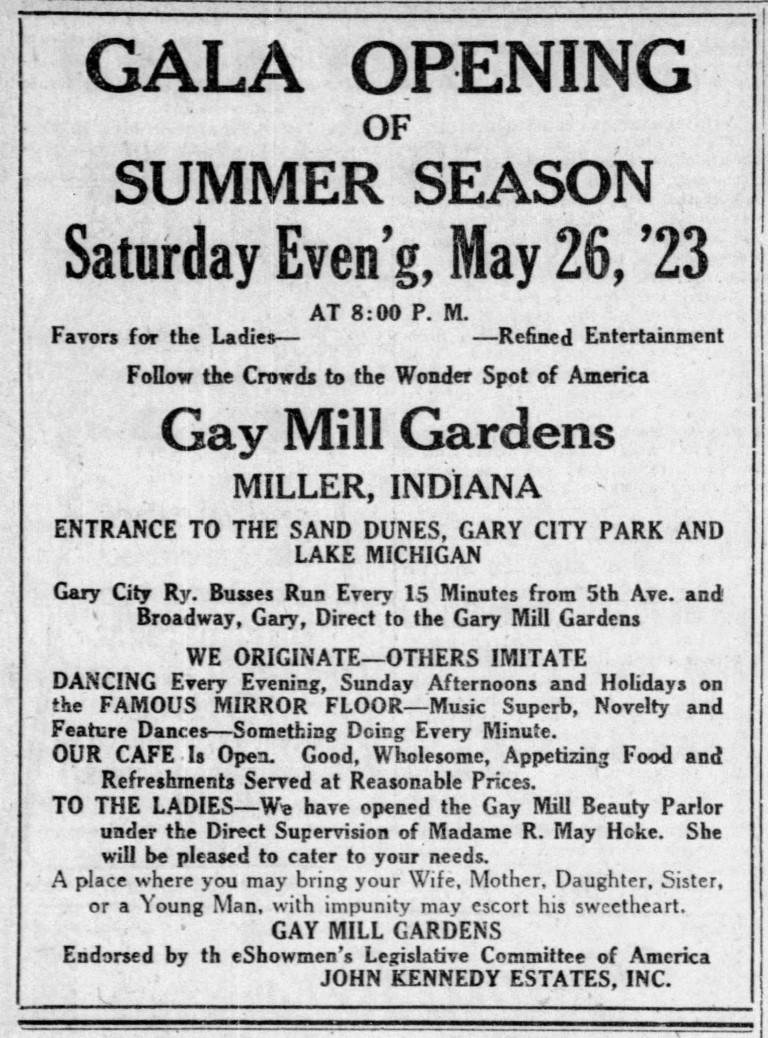
The hostesses are all young ladies who are residents of Gary and the old town of Miller. Their costumes are a combination of beauty and unique design. The color scheme is black and white, consisting of white satin smocks-black satin knickers-black Tommy Atkins’ Hats-trimmed in white and black swagger stick. And the head hostess is dressed in black and white also, but her costume differs from the other ones. She has a fitted military jacket-with a white satin cape lined in black thrown over one shoulder. The whole effect would have to be seen to be appreciated. A visitor to the Gay Mill Dance Shop stands in utter amazement at the brilliancy and cleanliness of the whole effect of the costumes.
The owners are determined to have none but the best people patronize their place. A visit to this place will convince you that they are certainly getting nothing but the best; even in view of the hardships one has to endure on account of the bad road between Gary and the Dance Shop, their business has increased over last year considerably-thereby demonstrating that nice people will patronize any place that is conducted in a clean, moral and wholesome manner, which speaks well of the management of the Dance Shop.”
By June 20, 1923 the road improvements had been made and “You can drive right up to the door of the Gay Mill Dance Shop.” A gala two day event for the Fourth of July featured Frances’ orchestra and Charles Cottle’s orchestra straight from Miami – with dancing on the mirrored dance floor. The season continued through to closing on Thanksgiving eve, November 28th with a three day celebration featuring a Derby Fox Trot and a Derby One Step with three prizes given on each night to the “runners.” (Footnote: “Gay Mill To Celebrate,” Hammond Times, Nov 24, 1923, page 5. Early dance marathons were sometimes called “derbies” and following the equestrian allusion, winners were “runners.” )
1924 - Gay Mill Takes Off
Success had begun in 1923, but in 1924 the place really took off, the dance season continuing into the fall with a fantastic Barn Dance. Frances, who couldn’t get the thrill of footlights out of her system, toured in the winter and spring of 1924: Boston, Elmira, Montreal, Philadelphia, Wilmington, Allentown. Those towns all saw her “singing monologue” between January and her return to Miller in May to open the “Dance Shop” - Gay Mill.

Seymour Simons, a well-known composer and orchestra leader who went on to compose “All of Me,” drew over six hundred couples to the first night of their week’s engagement that ended August 31st.(Footnote: “Gay Mill Has New Orchestra,” Hammond Times, Aug 26, 1924, page 8. )
At the beginning of September the older patrons formed a new social club, the Gay Mill Night Hawks, whose slogan was “Enemies of Sleep,” to hold suppers for members following the regular evening’s dance program. Frances directed the orchestra of “Ernie and His Nine Original Aces” in September. And from the 29th to October 4th the Night Hawks and the management put on a very successful “Country Barn Dance.” This sounds so fun I have to provide most of what Hammond Times reporter wrote about it:
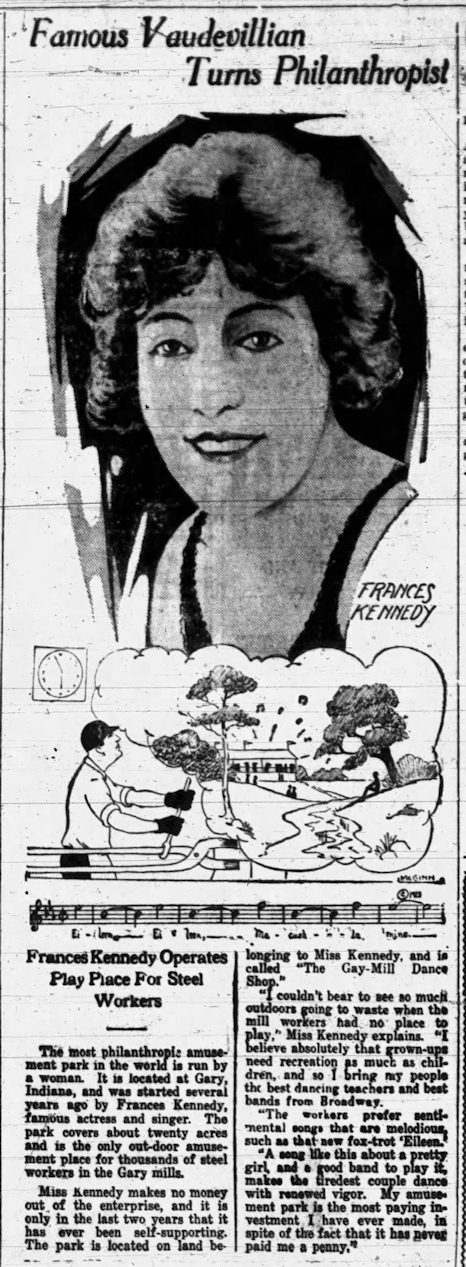 Gay Mill was attracting attention around the country thanks to the notoriety of Frances as a well-known vaudevillian: several papers, in Texas, Utah, and California, ran this flattering article in the late summer of 1924:
Gay Mill was attracting attention around the country thanks to the notoriety of Frances as a well-known vaudevillian: several papers, in Texas, Utah, and California, ran this flattering article in the late summer of 1924:
"Famous Vaudevillian Turns Philanthropist
----
Francis Kennedy Operates Play Place For Steel Workers"
“The Country Barn Dance or Harvest Party given under the auspices of the Gay Mill Night Hawks, at the Gay Mill Gardens has so far exceeded the expectations of everyone, that requests have been made to extend it into next week, but owing to other arrangements being made for the dancers next week this will be impossible.
Every evening the hall was crowded to capacity with people from Gary and adjoining cities, some dressed as country folks, while others were dressed as city folks, and all seemed to enjoy the spirit of the party.
The proprietors of the Gay Mill have spared no expense in making this a typical barn dance or harvest party, as you enter the once magnificent lobby, instead of the familiar electric lighted brightness you are confronted with barn lamps for lighting purposes, and the patrons must climb over the “stile’ to enter the hall. This affords a lot of merriment. The cashier is dressed in rube costume, and the door man is one of the constables. The hall is festooned with all sorts of farm products. As you proceed down the hall, you come to the old cross-road country store, which is presided over by Miss Kennedy. The patrons can get apple cider, homemade pies, apples, cheese and crackers, straw hats, jumpers, handkerchiefs, tobacco, stove polish and pipes. There is, of course, the old stove, with the familiar soap and cracker boxes all around it for the older country folks to sit around and chaw their tobacco.
Click here to read more or less.
Next to the country store you come to the poultry yard, with its geese, chickens and ducks, then the pig pen, where there are a number of young pigs and after that comes the sheep pen, the have even erected a barn for the horses. Of course there is also the old faithful watchdog. Around one end of the hall is baled hay for the country folks to sit on. There are also several farm implements and the farmer boys to sharpen their knives on the old grind stone, and then sit on the hay and whittle wood or swap stories.
The very unique and original signs are placed around the hall. For instance, one sign near the stove reads: ‘Don’t spit on the stove, but if you have to spit, spit on the stove.’ Another one reads: ‘Do not feed the hogs beefsteak.’
The hostesses are dressed in overalls, straw hats and red handkerchiefs and they look very cute in their farmer costumes. Of course, there is a raffle of the ducks, geese and chickens, several of the Garyites were very fortunate as they carried several of the poultry away with them.
The orchestra are dressed in rube costumes, and during the course of the evening render several old tunes such as are played down on the farm. The folks enjoyed the old Virginia reel, especially that part of it where the leading couple caught some couple in a basket and made the couple embrace as a forfeit. Then the circle two step, the robbers two step, and the old-fashioned quadrille, gig dancing and polkas were part of the evening’s sport.
[Three paragraphs omitted]A party of teachers and friends from Hammond numbering seventy-five, attended the dance and took part in the fun making. The proprietors of the Gay Mill are looking forward to a capacity crowd Saturday night, not only because it is the last night of the Barn dance, but because the Gay Mill Night Hawkes hold their weekly reception. Mr. Bill Childs, chairmen of the entertainment committee has arranged for a Dog and Badger contest for the entertainment of the members. Those who have never seen one of these contests at West Baden, at French Lick and other watering places, know what fun is afforded. Several entries have been made for the position of umpire or referee but so far no selection has been made.
The management has completed arrangements for dancing every night during the fall and winter months.
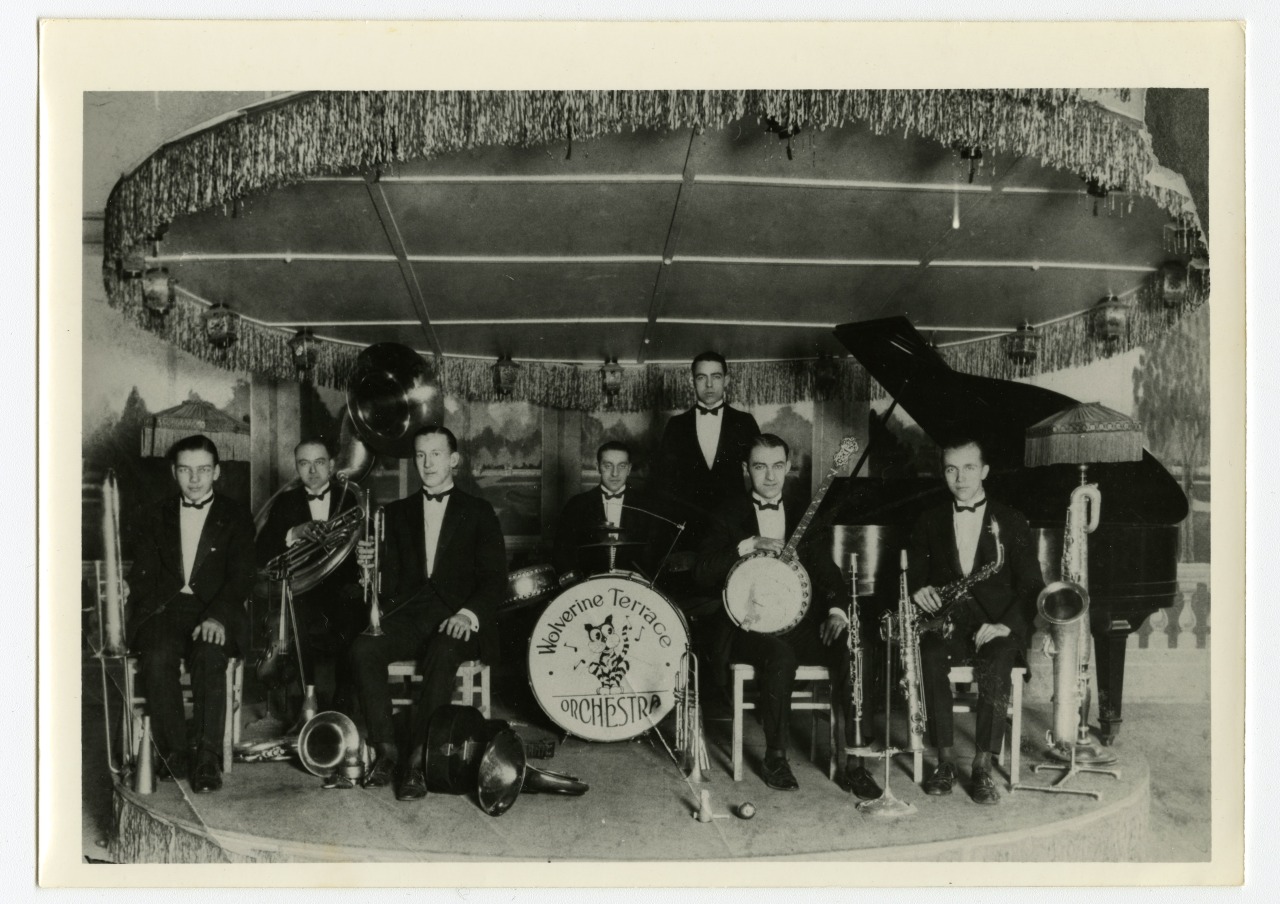
The Wolverine Terrace Orchestra from Detroit were on the bill Friday, October 24, 1924. Mardi Gras and Halloween Masquerades were planned for the following week. (Footnote: The Hammond Times, Ad for Gay Mill Gardens, Oct. 21, 1924, page 2. ) The Wolverine Terrace Orchestra, not to be confused with the Wolverine Orchestra from Davenport, Iowa who Bix Beiderbecke cut his teeth with, played numerous gigs at Gay Mill over succeeding years.
1925 - The Charleston
Buttons may not work on mobiles
January 10,1925
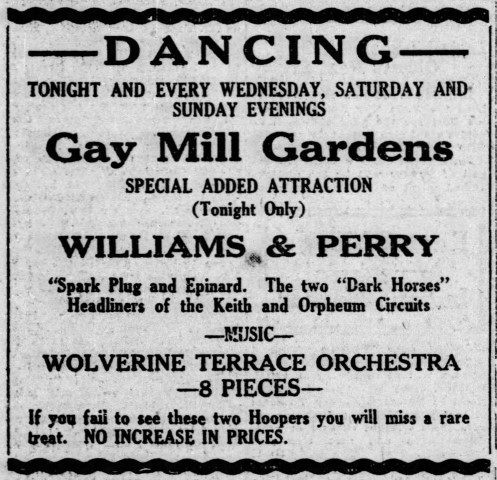
January 17, 1925
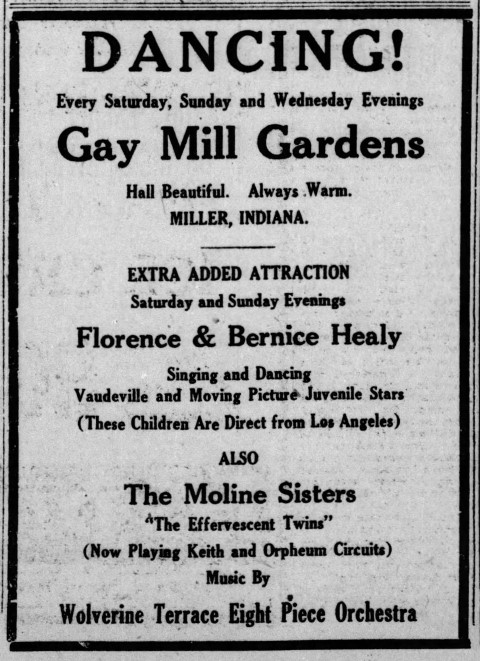
February 21, 1925
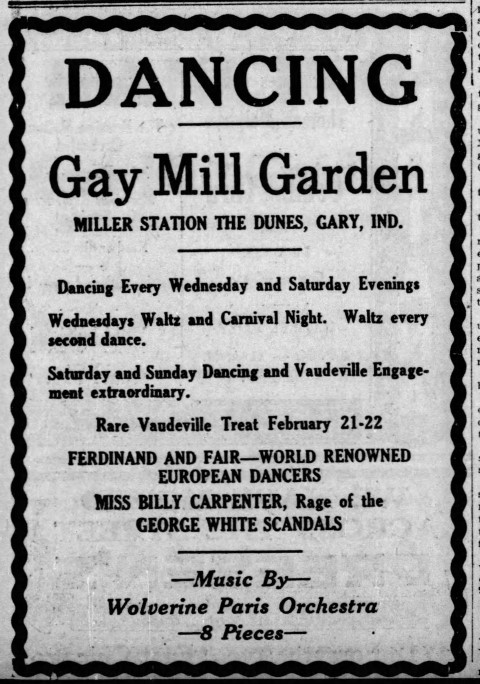
March 5, 1925
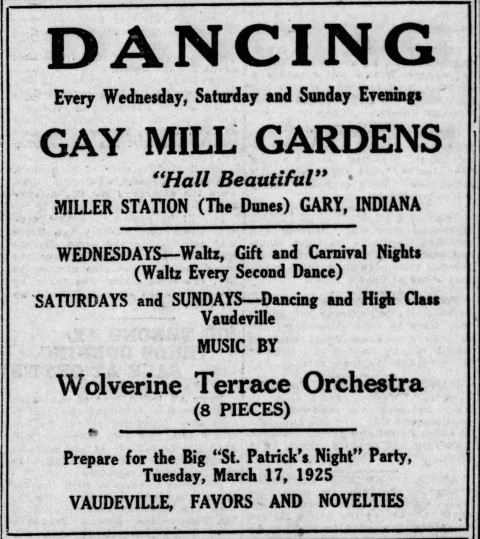
April 18, 1925
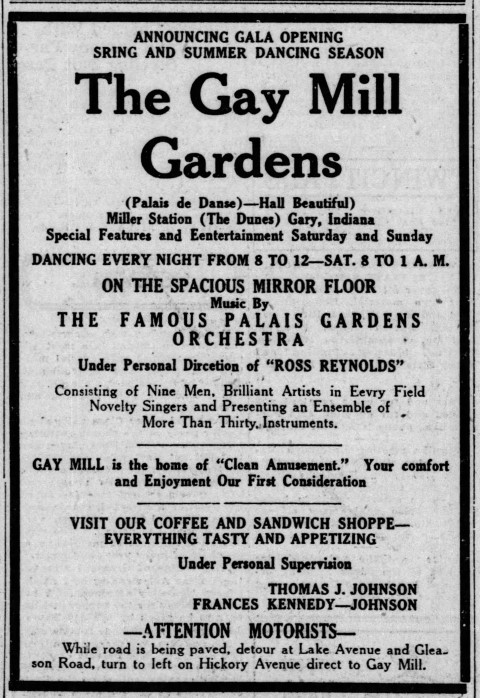
May 28, 1925
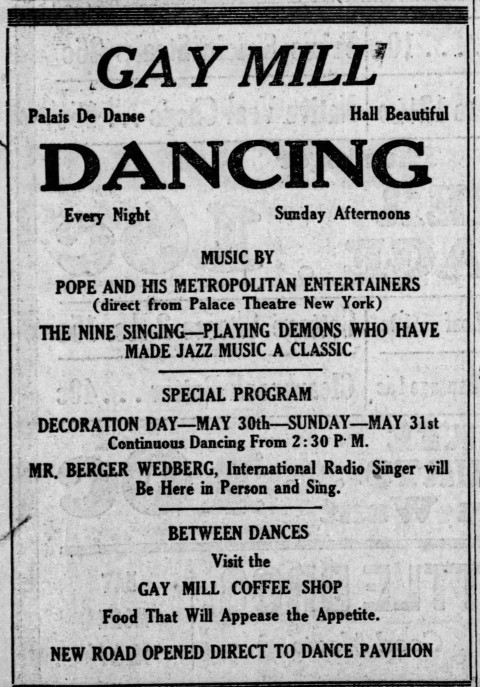
July 31, 1925
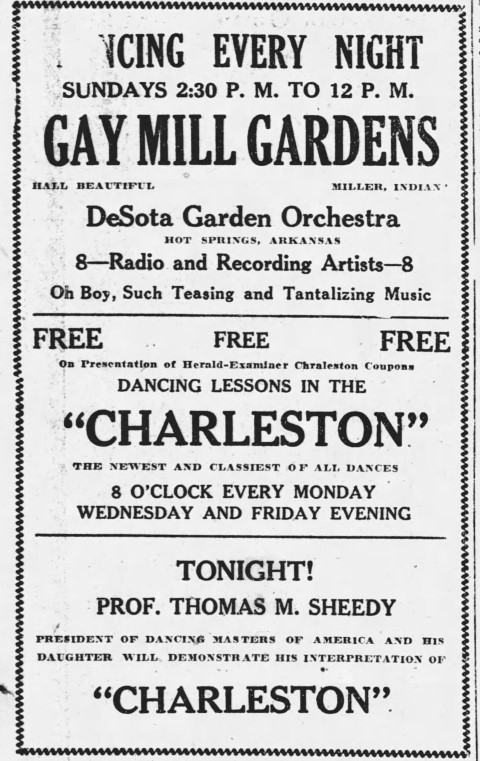
September 2, 1925
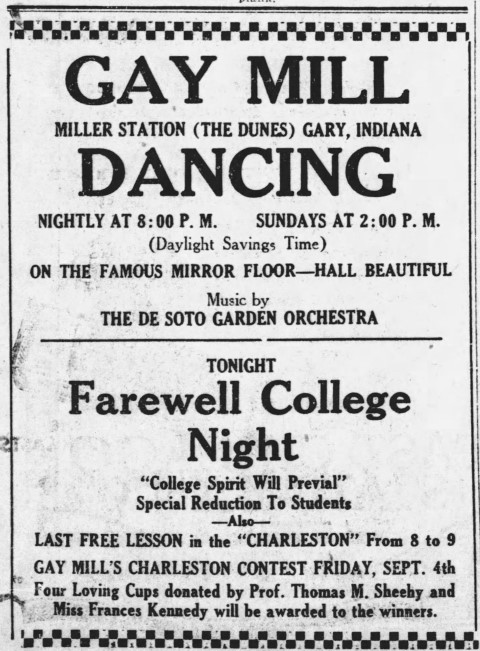
September 12, 1925
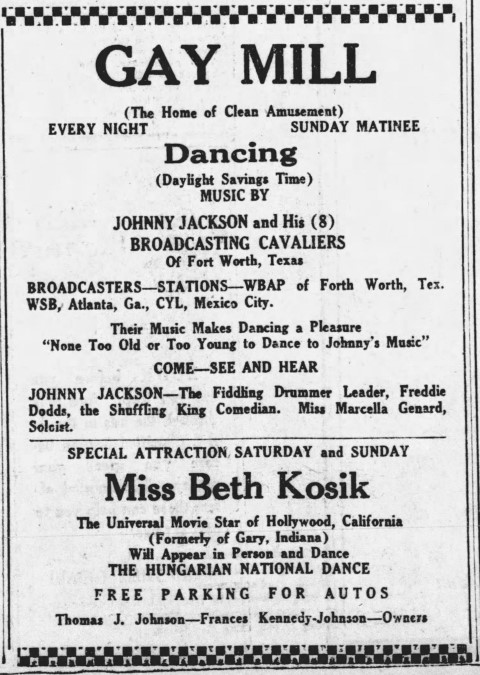
October 3, 1925
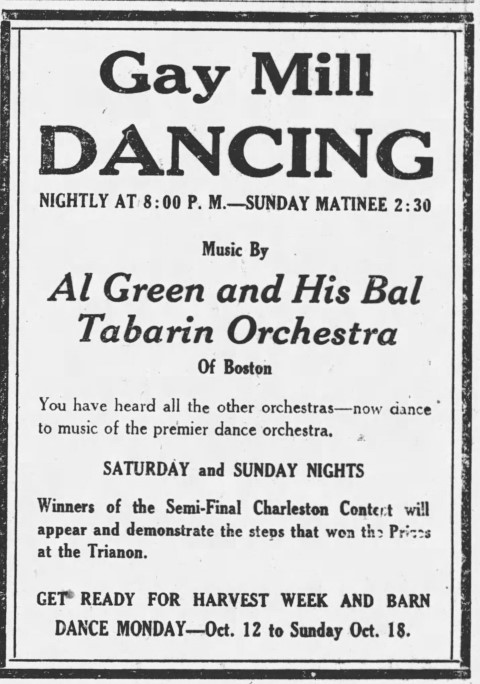
October 24, 1925
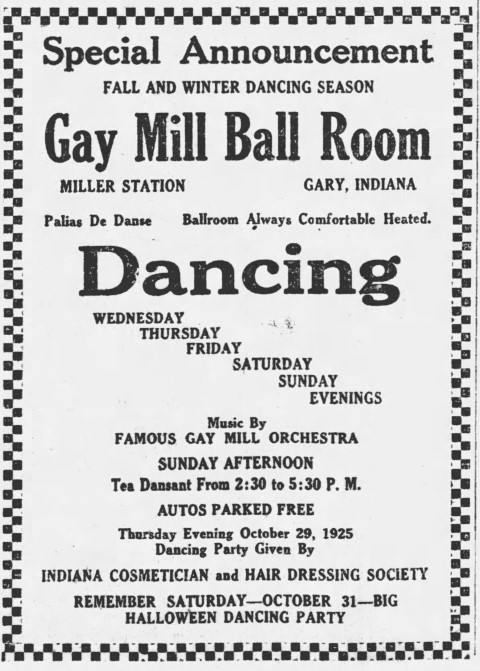
It’s rather impossible to record all the happenings at Gay Mill in 1925; the best way is to let your imagination go as you use the buttons above the ad to scroll through, and pause at, just eleven of the many, many ads that appeared in The Hammond Times that year. No doubt the men wore ties and the women what was fashionable; this was the day and age where men wore suits and ties to baseball games. Gay Mill was, after all, wholesome entertainment in the middle of prohibition.
At the end of July, Prof. Thomas Sheely, president of the Dance Masters of America visited Gay Mill to demonstrate the Charleston and other dances. (Footnote: “Famous Dancing Master to Visit Gay Mill,” Hammond Times, July 31, 1925, page 7. ) He’d been invited by Frances who had attended the Dance Masters convention in Chicago that last week in July. No one dance in American history has been so closely identified with any one period as the Charleston, and although a short-lived fad, (Footnote: Giordano, Ralph, Satan in the Dance Hall, Scarecrow Press, 2008, page 82. ) Gay Mill dancers joined the craze.
1926: Church and Radio WJKS "Where Joy Kills Sorrow"
Dancers at Gay Mill in the winter of 1925-26 certainly weren’t bereft of opportunity. Dancing music in February on Wednesday, Saturday and Sunday evenings was provided by the “house orchestra” directed by Virgil Moore: “Nine Snappy, Peppy, Singing Musicians.” There were Charleston dance lessons, private parties and a popular Chicago act of young girls: “Juvenile Follies” - the “Sensation of the Season.” (Footnote: Advertisement, Hammond Times, Feb 5, 1926, page 8. ) When spring finally came the entertainment at Gay Mill were glowingly reported in a column in Hammond Times by Theodora Wentz:
Gay Mill made her formal bow to spring and the 1926 dancing season in a whirl of new finery, gorgeous lighting effects, lilting syncopation, and the joyous laughter of the boys and girls of the surrounding country-side. The weather man had even polished up a brand new moon to give the necessary touch of romance to the occasion.
For a number of years, Gay Mill has been the ‘playtime place’ for young and old, but never before has she been so altogether lovely as at this season. There is a distinct atmosphere of clean, beautiful spaciousness from the moment you step through the door of the smart lobby, until you have your farewell ‘sip and bite’ in the Gay Mill Coffee Shoppe.
And whose shining personality radiates the whole lobby full of happiness from the striking painting of oil, hung in its golden frame to greet us as we enter? None other than our own Frances Kennedy, whose famous smile has made her beloved from coast to coast and border to border. True, the portrait is but a thing of oil, pigment and wood, but so magnetic is the personality of this charming woman, you feel the clasp of her hand in yours, extended with the warmest of personal welcomes. You see, she cannot be with us all the while, for the public is a very selfish thing, and clamors for the attention of its favorites. Miss Kennedy has been described throughout our country as “America’s Cheeriest Comedienne,” and it is indeed an apt description, for where Frances is, is love, and fun, and laughter, which are things she stands for.
Click here to read more or less.
It seems that the dainty dancing figures which adorn the massive beams, have just gathered all the gorgeous coloring out of a Dunes sunset, and scattered it over the heads of the whirling dancers below.
And those Gay Mill Funmakers - they have your heart all squeezed up in a knot of syncopation one moment, in shouts of laughter at their funny antics the next, and your feet – well, your feet just simply do things you never thought possible, to the strains of melody these master musicians evoke from their favorite instruments.
The hostesses this year have been carefully selected from hundreds of girls for their grace, dancing ability and personal charm. Here the boy who is lonely in a strange town, may be formally introduced to a lovely girl, exactly as he would be in his own home, enjoy a good dance to real music in the environment every mother wants for her boy.
Lester, Ltd., of Chicago, have designed, specially for the Gay Mill hostesses, quite the prettiest French dancing frocks we have seen in a long, long time. Quaint bodices of shimmering grey satin with fresh fluffy looking organdie collars, and the skirts are rows and rows of the sheerest grey gorgette crepe over net, with handmade roses and silver loops scattered here and there. Opera length hose and dancing bloomers to match, complete this delightful ensemble.
I must say another word for the cozy Coffee Shoppe. It is decorated to surpass many of our foremost metropolitan luncheon places, and the cooks certainly know the truth of the old saying ‘the way to a person’s heart is through the tummy.’ The sandwiches are particularly good, being made of delicious golden brown toast, with many new combinations for fillings, as well as the old.
Mr. Johnson has also supplied us with the finest and most up-to-date soda grille that thought and money and effort can purchase. Here you get any of your favorite thirst quenchers, from the lemon, orangeade and pop of circus days, to the most elaborate of sodas and iced drinks, to say nothing of the snowing mounds of ice cream, heaped high with fruits and nuts from every corner of the globe, and, always, throughout courteous, attentive service, which is a really big feature in itself.
Both Miss Kennedy, and her husband, Mr. Thomas J. Johnson, whose unceasing effort has made Gay Mill what it is today, have been a tremendous factor in building up the moral fibre of the youth of their particular territory, in providing them with a playground where they come in contact with only the finer elements of mirth and music.
The Gay Mill creed has always been to offer an environment where we may safely send our boys and girls to play in their leisure moments, and they have, indeed, succeeded.
Long may they be with us.
The birth of St. Mary of the Lake Roman Catholic church at Gay Mill
May 20th was the scene of a “delightful” party given by the Gary and Northern Indiana Hairdressers and Cosmetologists with much entertainment, and proceeds given for a uniform for the girls’ band of Emerson High School. But things really kicked off with the arrival for two nights of the Coon-Sanders and his Night Hawkes, a popular radio orchestra that broadcast from Chicago radio stations and toured extensively in the Midwest. (Footnote: Wikipedia article on Coon-Sanders in a new tab or window. ) Coon-Sanders and his Night Hawkes, originally from Kansas City, was the first dance orchestra in America to radio broadcast nightly. (Footnote: Walker, Leo. 1990. The Wonderful Era of the Great Dance Bands. New York, NY: Da Capo Press., page 164. ) Coon-Sanders would return several times, including the second weekend in June when he provided some of the music for the first Catholic Mass held at Gay Mill on Sunday, June 13th. Fr. Donnelly, the pastor of St. Luke’s Catholic Church in Gary, made arrangements to celebrate mass at 8 a.m. and the Johnson’s, “…always willing to cooperate in any movement for the betterment and uplifting of the morals of the community…will donate the use of their ball room to any recognized religious organization on Sunday morning for church or religious services.” Mass was held every Sunday morning throughout the summer months. (Footnote: “Will Hold Mass For Miller,” Hammond Times, June 8, 1926, page 5. ) This was the beginnings of the St. Mary of the Lake congregation, and although not formally erected as a parish church for three more years, the article says that “…before long a suitable church will be erected upon the property owned by the Johnsons, but the exact location of same has not been definitely decided upon.” There is no reason to suppose that the congregation did not continue to hold services at Gay Mill, in fact the 1930 Gary City Directory lists “St. Mary’s R C Church" at 540 N. Lake St. – Gay Mill. The next year saw St.Mary in a new building on Miller Ave. (Footnote: The Johnson’s had been married at Holy Name cathedral in Chicago in 1905, and Frances had sung from an early age in the choir of her parish church. -(“Attorney To Wed Actress,” The Inter Ocean (Chicago), June 20, 1905, page 2.) )
The Region’s First Radio Station – WJKS “Where Joy Kills Sorrow” – at Gay Mill in Miller.
If you’ve ever tuned into the Christian talk radio station WIND, AM 560 in Chicago, you’ve tuned into the direct descendant of the Calumet region's first radio station, WJKS, which operated at Gay Mill, 540 N. Lake Street in Miller from 1927 to 1932. It then moved the studios to 504 Broadway and the transmitter to the west side of Gary, changing the call letters to become WIND in 1933. Tom Johnson started the Johnson-Kennedy Radio Corporation in 1926, which company retained the license until Westinghouse Broadcasting Company became the license holder in the 1950s.
.jpg)
Thanks to the Johnsons, “Gary at last is to have an honest to goodness radio broadcasting station.” So read the article in the Hammond Times on November 26, 1926. Arrangements for installing the station at Gay Mill were complete and workmen were installing wiring and preparing to erect the 100 foot tall tower for the station which would broadcast as WJKS. Hammond Times reported on February 4, 1927 that “GARY’S FIRST AND ONLY broadcasting station located at Gay Mill will be ‘on the air’ within a short time.”
The whole story of WJKS (now WIND) and some notes about WJOB (originally WWAE) now is at its own webpage on this site. It is at
“Miller – The Site of the Region’s First Radio Station”
1927-1929: The first "Miss Indiana" pageant at Gay Mill
Dancing continued in 1927 along with church services in the summer, and the 500 watt radio station broadcasting from Gay Mill, but the visiting dance bands began to diminish, replaced by the “house orchestra” of the Gay Mill Orchestra, directed by various people, and no doubt with various musicians. Ads appeared weekly, sometimes daily on the weekends, throughout the year advertising dancing on Wednesday, Friday, Saturday and Sunday evenings. But perhaps the biggest event of 1927 was the very first (Footnote: The Wikipedia article on Miss Indiana says Wanda Marie Sobczak from Michigan City was crowned "Miss Indiana" at Gay Mill in 1926, but I find no evidence of that; there are various "Miss Indiana"s in the papers from different cities, including a Muncie girl, Miss Lova Henderson, age 16, who was to go to Atlantic City. The Miss Indiana website history says that the first Miss Indiana to compete in the 1927 Atlantic City pageant was a girl from South Bend, and that there were actually four entrants from Indiana that year. Miss Hammond, Anne Howe, finished in the top five. It was the infancy of the pageant; state and national procedures were not yet in place. There were 73 entrants in Atlantic City that year. ) “Miss Indiana” pageant which drew “The largest crowds that ever attended the affairs at Gay Mill Gardens…” on Saturday and Sunday nights, July 30 and 31st. (Footnote: “The Largest Crowd…” and “South Bend Girl Wins State Title,” Hammond Times, August 1, 1927, page 9. ) It was big doings: Frances and Tom entertained the contestants at a buffet luncheon Sunday, and Anna May Owens was crowned “Miss Gary” Sunday night. Four women went to Atlantic City in 1927 as "Miss Indiana."
It is difficult to know how much dancing went on in 1928 and 1929 at Gay Mill, although there is no reason not to suppose it was an active place with WJKS broadcasting
still from 504 N. Lake Street. In the winter of 1928-1929 the owners opened the Gay Mill Winter Ballroom in the Knights of Columbus Hotel at 5th and Madison,
but held a big New Year’s Eve dancing party in the Miller ballroom at the end of the year, with the dancing continuing the New Year day of 1929 at the K. of C.
In 1929 the owners leased the Elk’s Ball Room for the Winter Ballroom to open October 7th.
(Footnote:
“The Owners of Gay Mill Have Leased the K. C. Ballroom” Advertisement in the Hammond Times, December 14, 1928.
A formal opening December 16th with music by The Gold Dragons, “New York’s Latest Sensational Dance Orchestra.” (It is, after all, an ad.)
"Gay Mill Leases Elk's Ball Room," Hammond Times, September 28, 1929, page 13.
)
1930 - The Big (Long) Dance Marathon
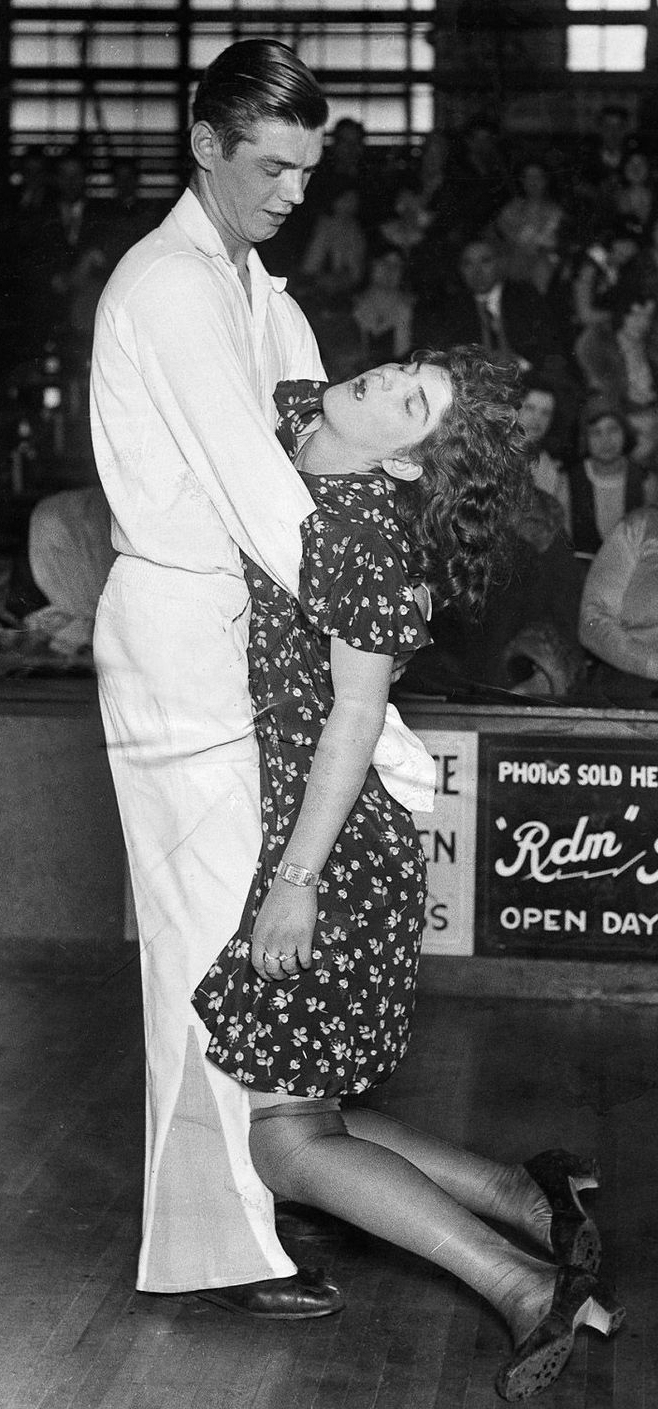
While the ads are still few and far between, dancing went on. In April Jack Chapman, a popular Chicago recording artist was secured to play. The big news of the year happened at the end of the year though, when on October 3rd eighty couples showed up to begin a dance marathon that would last for months competing for a thousand dollar prize. The dancers, who were allowed eleven minutes of rest an hour, (Footnote: Dance marathons around the country had different rules which is why any claim to the "longest" needs to take that into account. ) moved to the Elks Club in Gary on December 9th with 13 couples left in their 1634th hour of dancing. By late January shorter rest periods were put in to try and bring the marathon to a close, but on January 30th it had entered it’s 2,850th hour. Some five non-stop dancing contests were held on the same floor in conjunction with the marathon. By February 9th there were only two couples left, dancing with only four minutes an hour rest; an ad in the Gary Post-Tribune urged people to be there that night as it would finally end, which we can only assume it did.
Strangely enough, with all the press it had gotten over the months, with ads totaling the hours, a dancer coming down with an attack of appendicitis, the Mayor of Gary showing up to perform a marriage between one of the couples, there is no resolution in the papers! I’ve not found out who won! (Footnote: Details of the marathon were gleaned from many advertisements and notes that appear in the Hammond Times between October, 1930 and February, 1931. I’ve looked in vain through the February Gary Post-Tribune for results. )
1931 to the end in 1935
It has been written that Gay Mill burned down in 1930. It didn’t. Archibald McKinlay maintained that Gay Mill had become a liability for Tom Johnson and “For all its fame, however, Gay Mill’s future in the crash of 1929 looked anything but gay.” (Footnote: McKinlay, Archibald, “Sid Rice’s roots go deep,” Hammond Times, Jan 27, 1985, page 39. ) While that’s hard to refute, I would maintain that the opening of Madura’s Danceland, a stone’s throw from the popular Phil Smidt’s restaurant in Hammond in October of 1929 probably did more to diminish Gay Mill attendance. That large, new, lavish ballroom capable of handling the big bands that would become popular in the 30s and 40s was closer to the market for dancers. Another huge rival for entertainment dollars came at that time as well: talking pictures.
“Gay Mill Plans Opening” read the headline of a brief note in Hammond Times on April 8, 1931. On July 11th there were reportedly 2,000 dancers jammed into
Gay Mill for the “first annual movie relief ball” sponsored by the Fraternal Order of Police to raise money for needy families in the city.
(Footnote:
“Gay Mill Plans Opening,” Hammond Times, April 8, 1931, page 13: “Spring in Miller, Gary and the Calumet Region, means the annual reopening of that
institution of terpischore, the Gay Mill amusement center at Miller, in existence for almost twelve years, giving joy and amusement to two
generations of dance lovers. An enormous crowd is expected at the Gay Mill next Sunday and Saturday to justly celebrate the occasion…”
“Many Attend Gary Movie Ball,” Hammond Times, July 13, 1931, page 11.
)
In the summer of 1931 the Johnsons leased Gay Mill to Alex Ganovich and Sidney Rice for $7,500. They were sued by the Johnson’s for violating the terms of the
lease, lost, and the management was back in the hands of the Johnsons.
(Footnote:
“Norton Rules Clause Voids Garden Lease,” Hammond Times, October 31, 1931, page 1.
)
They tried to compete. “It will not be the fault of Thomas J. Johnson,
the well known owner of Gay Mill Gardens, if the popular recreation center at Miller does not record the gayest season of winter months in the history of the
amusement place, according to present plans” read the note in Hammond Times in late August.
(Footnote:
“Gay Mill Looks For Gay Season,” Hammond Times, Aug 27, 1931, page 11.
)
There are scattered reports in the papers of dances being held at Gay Mill in 1932; there were benefits, one for the Fraternal Order of Police, one for Municipal League,
and then a “Repeal Dance” in June which featured the short-lived all girl orchestra of “Mary and Her Platinum Blondes,” followed the next weekend by
Half-Pint Jaxon, the 5’2” widely popular entertainer.
(Footnote:
“Gay Mill Will Hold Repeal Dance Saturday,” Gary Post-Tribune, June 10, 1932, page 11.
Frankie “Half-Pint” Jaxon has his own Wikipedia article and there are several YouTube videos that feature his recordings.
)
On July 15, 1933 the Valparaiso Vidette-Messenger reported Gay Mill would reopen under new management with Joe Morris the general manager and Ted Nering and his eleven piece orchestra playing
dance music. One can only speculate that after the summer of 1933 Gay Mill was abandoned; in August of 1934 it was burgled, a suspect caught in September who was charged with
sacking “…the place of all furniture, equipment and lighting apparatus.”
(Footnote:
“Sheriff Nabs Man Wanted for Robbery,” Hammond Times, September 11, 1934, page 7.
)
The 1935 City Directory lists 540 N. Lake Street as “vacant” and on October 16th, by order of the
State fire marshal in a petition in the Gary superior court, the building was ordered to be dismantled within 30 days or there would be severe fines to the holding company, a trustee of the Johnsons.
(Footnote:
“Gay-Mill, Miller Dance Hall Must Be Razed, Is Order,” Gary Post-Tribune, October 15, page 4. The article falsely states that “The dance hall has not been in use since 1930.”
)
So ended an era. Thomas J. Johnson, Sr. out-lived his wife Frances by nine years, dying in 1958. Frances, who had a vibrant and entertaining career in show business,
died in 1949 noted only in a short seven line death notice in the Chicago Tribune. She will be the subject of companion web page.
Their son, Thomas Junior would become an assistant Chicago city attorney while daughter Frances, after a brief period in radio and theater, pursued a career in retailing, dying in California in 1996.
Appendices: personal remembrances
There are several recorded memories of Gay Mill both in the Calumet Archives and in Linda Simon and Jane Ammeson's book Miller Beach (page 91.) These are delightful and instructive. The only caveat I have to them are references to some of the performers mentioned, Jack Benny and Paul Whitehead's orchestra, for example: I've never found specific mention of them being at Gay Mill in the newspapers of the time, but that doesn't mean they weren't at Gay Mill. I do know that Frances toured with Jack Benny to the west coast and that he, and the other performers mentioned, toured in Indiana and further afield in the time frame.
Be that as it may, I've provided two such remembrances here. The first is from Esther Pearson, a school teacher who lived on East Sixth Place and wrote a history of Miller in 1972. The second is in the Calumet Archives, but the date and author are unknown to me at this time.
Esther Pearson:
In the early l920's Gay Mill was built. Thomas Johnson an attorney from Chicago with his wife Frances Kennedy, who was a vaudeville performer, opened a dance and recreation hall on the west side of Lake Street just south of the Grand Calumet. They called this dance hall Gay Mill Gardens and they had name bands from all over the country. Among them were Paul Whiteman, Ted Weems, and Wayne King to name a few. Then in February l927 with the help of Judge Gary they received o a license to operate Gary’s first Radio Station which they named W.J.K.S. W the call letter and J.K.S. was Johnson, Kennedy, and Son, but they called it "Where Joy Kills Sorrow”.
In August 1927 there was a formal grand opening and dedication when Johnson turned over this Radio Station to the City of Gary. At this formal opening some of the speakers were Mr. Gleason, Norton, Mayor Williams, Reverend Backmeyer, Rabbi August, and Reverend Deville. Some performers at W.J.K.S. were D.M. Ward, and you probably know these people, Ray ([not readable]), D.S. Davies who had a beautiful baritone voice, the Indiana Male Quartette, Alberto Duetterez from Argentina who played the guitar, Bonanova the Spanish baritone, Fredricka Pickart Grand Opera, W.J. Funky Jr, the Slag Pocket Four which was four Open Hearth employees, the Strom Sisters, and Bessie Franson was Staff Accompanist. The place was policed by two Detectives Gus Youngheim and Clyde Dennison and they kept things OK.
At this time Streetcars from Gary went as far as Lake Street just south of the Baltimore and Ohio tracks in Miller, that is they went from 5th and Broadway in Gary to just south of the Baltimore and Ohio tracks in Miller. Then from there a Jitney went to Gay Mill or a Jitney could be taken from 5th and Broadway to Gay Mill for 25¢. Gay Mill was forced to close at the beginning of the Depression and the building burned down in 1930.
Unknown:
Back in the 20’s Miller used to be the town for entertainment. Our town drew people (a lot of rich people) from as far away as Chicago. Before there were cars people would come by horse and wagon along the shores of Lake Michigan, on the harder sand. Miller was an all day trip from Chicago by wagon. Later on there was the train, and a bus service from the depot. Most people came to Gay Mill a dance type social hall, every Saturday and Sunday.
I was on the staff at Gay Mill and there were five other girls. Our job was to be a hostess and take tickets for each dance. We girls were not supposed to accept any dances while on the job but it became very hard sometimes to stick to the rules.
Our uniforms were not at all like you would see your modern day hostess in. All six of us girls were outfitted in white satin dresses and white felt tams. I guess you could say we looked like the “Cat’s Meow”.
I don’t want to forget to tell you about our boss or the host at Gay Mill. He was then what is now known as a bouncer. The thing that was watched closely in our place, was that couples didn’t dance too close together. The forbidden dance then was the “Shimmy”. I suppose it did look a little immoral but it sure was fun to get out there and really wiggle.
I will end my story here because after the 30’s Miller was no longer at her finest. Like everyone else I prefer to mention happy times.
Photo and Image Credits not in footnotes:
- Map from the County Surveyor's Office website. Should you own property either side of Lake Street south of the lagoon you may see on your deed that your lot is in a subdivision of "Johnson-Kennedy Estates." Click on the map to get an idea of the land that they owned, although this only shows subdivisions 1,2,4 and 5, while the Gay Mill property was never subdivided evidently.
- Photo of Gay Mill is from the 1925 City Directory ad. There is a clearer image from a post card with the same angle at Hoosier Recollections Search "Gay Mill" as there is also a clear close up.
- Advertisements and the Frances Kennedy article with picture are saves from Newspapers.com for the most part.
- Seymour Simons band photo from the Jewelant Blog.
- Wolverine Terrace Orchestra is from the Duncan P. Schiedt Photograph Collection at the Smithsonian put online at http://dcaap.tumblr.com.
- Gay Mill photo: Calumet Regional Archives (Used in Linda Simon and Jane Ammeson's Miller Beach)
- Hostesses: Calumet Regional Archives (Used in Pictoral History)
- Marathon dancers from the web.
- Photo of Mary and her Platinum Blondes is from Pool, Jeannie G., Lily Tomlin, and Jane Wagner. 2010. Peggy Gilbert & her all-girl band. Lanham, Md: Scarecrow Press.
- Photo of Frankie "Half-Pint" Jaxon is a screen capture from a YouTube video of his music.
Other Credits:
The Lake County Library Genealogy Room for use of their microfilm.
Steve McShane at the Calument Regional Archives. Linda Simon. Jane Ammeson.
Footnotes could not have been done without the scripts and instructions at Easy Footnotes for Web Pages (Acessibility friendly)
Footnotes:
Page created January, 2019. Comments and questions?
Feel free to contact me about this page.
